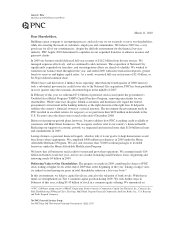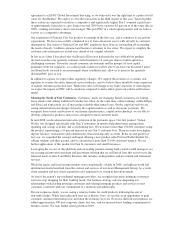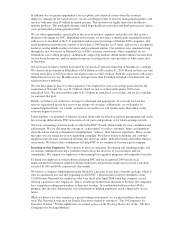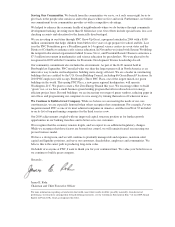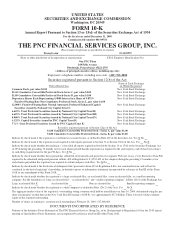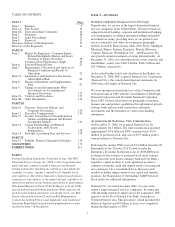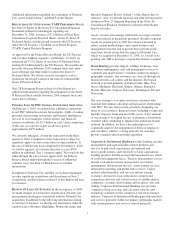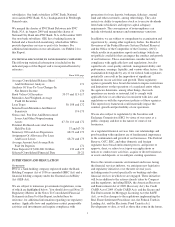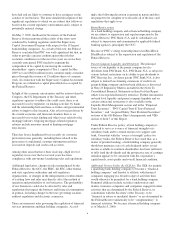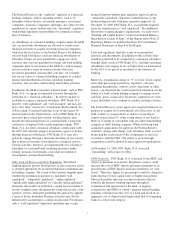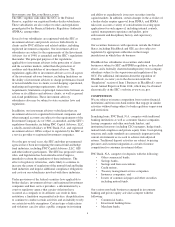PNC Bank 2009 Annual Report Download - page 2
Download and view the complete annual report
Please find page 2 of the 2009 PNC Bank annual report below. You can navigate through the pages in the report by either clicking on the pages listed below, or by using the keyword search tool below to find specific information within the annual report.agreement to sell PNC Global Investment Servicing, as we believed it was the right time to capture its full
value for shareholders. We expect to close the transaction in the third quarter of this year. Taken together,
these actions are expected to result in a competitive and significantly higher Tier 1 common capital ratio
of approximately 8 percent on a pro forma year-end 2009 basis, up from 4.8 percent as of the same date in
2008 – making our balance sheet even stronger. This puts PNC in a solid capital position, and we believe
it gives us a competitive advantage.
Our acquisition of National City was positive to earnings in the first year, and it continues to exceed our
expectations. We have successfully completed two of four conversion waves with virtually no customer
interruptions. Our teams of National City and PNC employees have done an outstanding job in meeting
the needs of nearly 3 million consumer and business customers in five states. We expect to complete the
customer conversion process at mid-year, ahead of our original schedule.
In last year’s letter I described why our Board of Directors had made the very difficult but prudent
decision to reduce our quarterly common stock dividend to 10 cents per share to build capital in a
challenging economy. Given the current economic environment and the prospect of new capital
guidelines from our regulators, we cannot predict when we will be able to increase our dividend. I know
our Board looks forward to an environment where conditions may allow us to increase the quarterly
dividend PNC pays to you.
In addition to capital, we expect other regulatory changes. We support the creation of a systemic risk
regulator to oversee the entire financial services industry, and we believe there should be some expansion
of federal consumer protection laws. While new rules will change every bank’s business to some degree,
we expect the impact on PNC will be moderate compared to many others given our culture and business
model.
Meeting the Needs of Our Customers. Customers’ needs are changing. Retail consumers are writing
fewer checks and visiting traditional branches less often. At the same time, online banking, online bill pay
and debit card transactions are all increasing at double-digit annual rates. On the corporate side we are
seeing similar behavioral changes driven by the capital markets as well as electronic payments. We
recognize those trends and because of our financial performance, capital and technology, we are able to
develop competitive products and services designed to meet customer needs.
In mid-2008, we developed an innovative platform in the payments space. Our first product, Virtual
Wallet, was designed specifically with Gen Y consumers in mind to help them better manage their
spending and savings activities and avoid banking fees. We now have more than 150,000 customers using
the product, representing a 14 percent increase in our Gen Y customer base. These accounts have higher
deposit balances, transactions and retention rates than checking-only accounts. In the second quarter of
last year, we expanded the concept and began offering a new product called Virtual Wallet Student for
college students and their parents, and we already have more than 32,000 customers using it. We see
further applications of this product for Gen X consumers and small businesses.
Leveraging the success of this platform and our leading position among bank-owned wealth managers, we
are creating an innovative payment and investment offering that we will unveil later this year to serve the
financial needs of Gen X and Baby Boomers that includes credit products and investment and retirement
services.
While the equity and fixed income markets were exceptionally volatile in 2009, our high net worth and
institutional clients benefited from the counsel and services of our Asset Management Group. As a result,
client retention and new client acquisition rates remained very strong in this environment.
As one of the nation’s top residential mortgage providers, we recognize that many mortgage customers
want one-stop shopping for their banking needs. Our business strategy calls for deepening our
relationships with existing mortgage customers and offering mortgage products and services to new
customers consistent with our commitment to a moderate risk philosophy.
For our corporate clients, we are seeing a return to banks for credit products following the exit of
non-bank lenders. While loan utilization rates are at historic lows, we see this as an opportunity to gain
customers and meet their needs now and when the economy recovers. Even in a difficult environment, we
added approximately 500 new corporate clients last year, and we increased new lending commitments to
business clients. We seek further client growth in 2010.

